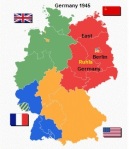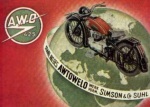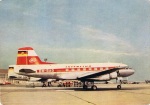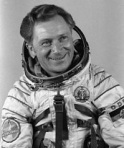VINTAGE GERMAN RUHLA DIGITAL WATH JUMP HOUR
ORIGINAL, EXCELLENT CONDITION
THIS IS GERMAN WIND UP JUMP HOUR DIGITAL WATCH.
MADE IN GDR ( GERMAN DEMOCRATIC REPUBLIC )
BASE IS IN GOOD USED CONDITION . ON STEEL COVER WATH IS MARKED BY INOX AND ANTIMAGNETIC FUNCTION. THE DIAL AND GLASS HAS EXCELLENT. THE WATCH IS IN WORKING CONDITION. WATCH HAS 37MM WIDE WITH CROWN AND 27MM DIAMETER OF DIAL AND LUG TO LUG IS 40MM.
REPLACED NEW BRACELET.
SOLD
Short History of Ruhla Watches
A Short History of Ruhla Watches (updated 13/1/2011)
With the end of the Second World War and the Soviet liberation of eastern Europe, the allied forces took administrative control of Germany. In Eastern Germany, Soviet forces remained and started to rebuild the economy and manufacturing. To this end, the former clock and engine works of brothers Thiel GmbH Ruhla came under the control of the Soviet state enterprise Avtovelo. Avtovelo controlled several factories one of which was the BMW motorworks in Eisenach which later became the Wartburg Motor Works.In 1952, the enterprise was transferred to the new East German State and became the VEB Clock and Engine works Ruhla – VEB, Volkseigener Betrieb (an enterprise owned by the people) . This was the legal form of industrial enterprise in East Germany. VEBs were publically owned and were routinely combined with other organisational units called Kombinaten. Later the works became the Uhren und Maschinenfabrik Ruhla – hence UMF seen on earlier watch dials.
The Ruhla works developed clocks and instruments throughout the 1950s and 60s. For example, in cooperation with the Soviet aircraft maker Ilushin in the mid 1950s VEB Ruhla developed calibres for use in aircraft in East Germany and the Soviet Union (Ilyshin 14) as well as electrical clocks, automatic controllers and such instruments as chess clocks as well as heavier machinery such as milling machines.
Some early calibres developed by VEB Ruhla in the late 1940s, early 1950s proved difficult to sell and to manufacture. Some of the parts required could not be made within the East German economy which meant sourcing these components from the west. This resulted in both economic and political difficulties. Firstly, in economic terms the foreign exchange costs involved were not sustainable and politically, East German production was meant to be free from capitalist interference which precluded sourcing materials or components from the west.
In the early 1960s, as a response to this, Ruhla developed the caliber 24 design. The caliber 24 proved very successful and many variations were produced. Within a few years, production had reached 5 million units and virtually all materials and components were produced in-house.
It was in 1967 that the Ruhla works became part of a combine (Kombinaten) along with other clock manufacturing plants such as Glaschutte and Weimar although each plant remained economically independent. The kombinaten employed approximately 7,500 people.
Around 60% of production at VEB Ruhla was exported to western countries. In the Federal Republic (West Germany) Ruhla watches were sold through department stores and catalogue companies. Ruhla also exported movements to be cased-up in the Far East. Catalogues were also popular in East Germany and the State department stores produced catalogues of goods from the 1950s onwards. Both Ruhla and Glashütte products were sold via this means.
The success of these calibres and the high production volumes resulted in the automation of the assembly process at Ruhla. Three parallel assembly lines were developed in 1971.
In 1978 there was a further restructuring of the East German watch industry and Ruhla then became part of the Kombinat Mikroelektronik Erfurt. An electro-mechanical movement was developed , the caliber 25. This caliber was used not only in watches but also car dashboard clocks and alarm clocks. The technical developments made in the caliber 25 provided the East German watch industry with the prerequisites for developing quartz watches. The first quartz digital watch were put into production as the UMF 28-40 calibre.
In this same year, East Germany entered the space race through the Soviet space programme. An electro-mechanical stop watch was tested during the first space mission undertaken by Sigmund Jähn of the East German Airforce aboard the Soyuz 31 and 29 to and from the Salyut 6 space station in August/September 1978.
Later, during the early 1980s, development work concentrated on quartz wrist watches and clockwork movements such as the UMF M 24 and quartz alarm movements; much of the production of which was destined for the East German domestic market. The East German Goverment took the view that LCD quartz watches would be the future for watch production.
During its lifetime, the Ruhla clock works manufactured many hundreds of millions of clock movements of different calibres. A full list of calibres is available here: Ruhla Calibre List
Following the re-unification of Germany, the kombinaten was broken up and different enterprises developed. VEB Ruhla was converted to a limited company (GmbH) many staff were layed off or put on temporary contracts and by 1991, the factory ceased production. However, an engineer of the VEB Ruhla plant and two other colleagues bought the clock plant which became Gardé Ruhla and which still successfully manufactures quartz watches today.












1 comment:
The short history of Ruhla watches above was taken from Ostalgieruhla.wordpress.com.
Sekondtime
Author of:
Ostalgieruhla.wordpress.com
Sekondtime.wordpress.com
Post a Comment